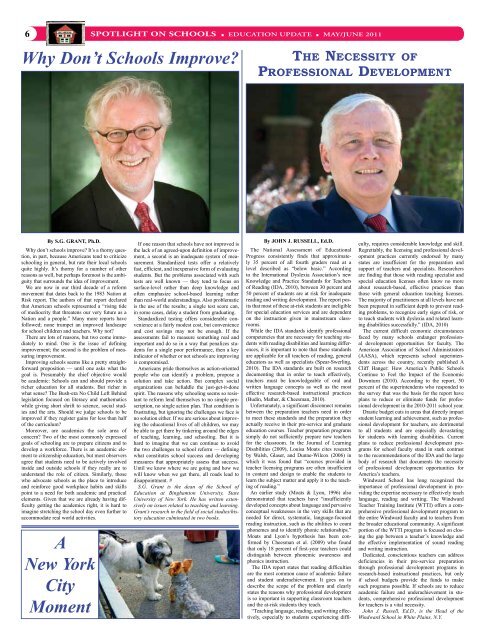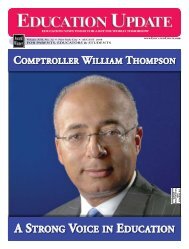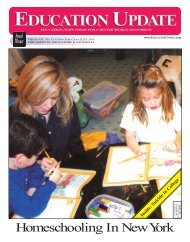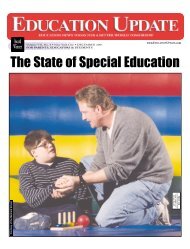Create successful ePaper yourself
Turn your PDF publications into a flip-book with our unique Google optimized e-Paper software.
6 spotlight on schools ■ EDUCATION UPDATE ■ MAY/JUNE 2011Why Don’t Schools Improve?The Necessity ofProfessional DevelopmentBy S.G. Grant, Ph.D.Why don’t schools improve? It’s a thorny question,in part, because Americans tend to criticizeschooling in general, but rate their local schoolsquite highly. It’s thorny for a number of otherreasons as well, but perhaps foremost is the ambiguitythat surrounds the idea of improvement.We are now in our third decade of a reformmovement that dates back to the 1983 Nation atRisk report. The authors of that report declaredthat American schools represented a “rising tideof mediocrity that threatens our very future as aNation and a people.” Many more reports havefollowed; none trumpet an improved landscapefor school children and teachers. Why not?There are lots of reasons, but two come immediatelyto mind. One is the issue of definingimprovement; the second is the problem of measuringimprovement.Improving schools seems like a pretty straightforwardproposition — until one asks what thegoal is. Presumably the chief objective wouldbe academic: Schools can and should provide aricher education for all students. But richer inwhat sense? The Bush-era No Child Left Behindlegislation focused on literacy and mathematicswhile giving short shrift to science, social studiesand the arts. Should we judge schools to beimproved if they register gains for less than halfof the curriculum?Moreover, are academics the sole area ofconcern? Two of the most commonly expressedgoals of schooling are to prepare citizens and todevelop a workforce. There is an academic elementto citizenship education, but most observersagree that students need to be actively involvedinside and outside schools if they really are tounderstand the role of citizen. Similarly, thosewho advocate schools as the place to introduceand reinforce good workplace habits and skillspoint to a need for both academic and practicalelements. Given that we are already having difficultygetting the academics right, it is hard toimagine stretching the school day even further toaccommodate real world activities.ANew YorkCityMomentIf one reason that schools have not improved isthe lack of an agreed-upon definition of improvement,a second is an inadequate system of measurement.Standardized tests offer a relativelyfast, efficient, and inexpensive form of evaluatingstudents. But the problems associated with suchtests are well known — they tend to focus onsurface-level rather than deep knowledge andoften emphasize school-based learning ratherthan real-world understandings. Also problematicis the use of the results; a single test score can,in some cases, delay a student from graduating.Standardized testing offers considerable convenienceat a fairly modest cost, but convenienceand cost savings may not be enough. If theassessments fail to measure something real andimportant and do so in a way that penalizes studentsfor a single poor performance, then a keyindicator of whether or not schools are improvingis compromised.Americans pride themselves as action-orientedpeople who can identify a problem, propose asolution and take action. But complex socialorganizations can befuddle the just-get-it-donespirit. The reasons why schooling seems so resistantto reform lend themselves to no simple prescription,no single action plan. That condition isfrustrating, but ignoring the challenges we face isno solution either. If we are serious about improvingthe educational lives of all children, we maybe able to get there by tinkering around the edgesof teaching, learning, and schooling. But it ishard to imagine that we can continue to avoidthe two challenges to school reform — definingwhat constitutes school success and developingmeasures that appropriately assess that success.Until we know where we are going and how wewill know when we get there, all roads lead todisappointment. #S.G. Grant is the dean of the School of<strong>Education</strong> at Binghamton University, StateUniversity of New York. He has written extensivelyon issues related to teaching and learning.Grant’s research in the field of social studies/historyeducation culminated in two books.By John J. Russell, Ed.D.The National Assessment of <strong>Education</strong>alProgress consistently finds that approximately35 percent of all fourth graders read at alevel described as “below basic.” Accordingto the International Dyslexia Association’s newKnowledge and Practice Standards for Teachersof Reading (IDA, 2010), between 30 percent and50 percent of students are at risk for inadequatereading and writing development. The report positsthat most of these at-risk students are ineligiblefor special education services and are dependenton the instruction given in mainstream classrooms.While the IDA standards identify professionalcompetencies that are necessary for teaching studentswith reading disabilities and learning differences,it is important to note that these standardsare applicable for all teachers of reading, generaleducators as well as specialists (Spear-Swerling,2010). The IDA standards are built on researchdocumenting that in order to teach effectively,teachers must be knowledgeable of oral andwritten language concepts as well as the mosteffective research-based instructional practices(Budin, Mather, & Cheesman, 2010).Unfortunately, a significant disconnect remainsbetween the preparation teachers need in orderto meet these standards and the preparation theyactually receive in their pre-service and graduateeducation courses. Teacher preparation programssimply do not sufficiently prepare new teachersfor the classroom. In the Journal of LearningDisabilities (2009), Louisa Moats cites researchby Walsh, Glaser, and Dunne-Wilcox (2006) inwhich it was found that “courses provided inteacher licensing programs are often insufficientin content and design to enable the students tolearn the subject matter and apply it to the teachingof reading.”An earlier study (Moats & Lyon, 1996) alsodemonstrated that teachers have “insufficientlydeveloped concepts about language and pervasiveconceptual weaknesses in the very skills that areneeded for direct, systematic, language-focusedreading instruction, such as the abilities to countphonemes and to identify phonic relationships.”Moats and Lyon’s hypothesis has been confirmedby Cheesman et al. (2009) who foundthat only 18 percent of first-year teachers coulddistinguish between phonemic awareness andphonics instruction.The IDA report states that reading difficultiesare the most common cause of academic failureand student underachievement. It goes on todescribe the scope of the problem and clearlystates the reasons why professional developmentis so important in supporting classroom teachersand the at-risk students they teach.“Teaching language, reading, and writing effectively,especially to students experiencing difficulty,requires considerable knowledge and skill.Regrettably, the licensing and professional developmentpractices currently endorsed by manystates are insufficient for the preparation andsupport of teachers and specialists. Researchersare finding that those with reading specialist andspecial education licenses often know no moreabout research-based, effective practices thanthose with general education teaching licenses.The majority of practitioners at all levels have notbeen prepared in sufficient depth to prevent readingproblems, to recognize early signs of risk, orto teach students with dyslexia and related learningdisabilities successfully.” (IDA, 2010)The current difficult economic circumstancesfaced by many schools endanger professionaldevelopment opportunities for faculty. TheAmerican Association of School Administrators(AASA), which represents school superintendentsacross the country, recently published ACliff Hanger: How America’s Public SchoolsContinue to Feel the Impact of the EconomicDownturn (2010). According to the report, 50percent of the superintendents who responded tothe survey that was the basis for the report haveplans to reduce or eliminate funds for professionaldevelopment in the 2010‐2011 school year.Drastic budget cuts in areas that directly impactstudent learning and achievement, such as professionaldevelopment for teachers, are detrimentalto all students and are especially devastatingfor students with learning disabilities. Currentplans to reduce professional development programsfor school faculty stand in stark contrastto the recommendations of the IDA and the largebody of research that documents the necessityof professional development opportunities forAmerica’s teachers.Windward School has long recognized theimportance of professional development in providingthe expertise necessary to effectively teachlanguage, reading and writing. The WindwardTeacher Training Institute (WTTI) offers a comprehensiveprofessional development program tothe entire Windward faculty and to teachers fromthe broader educational community. A significantportion of the WTTI program is focused on closingthe gap between a teacher’s knowledge andthe effective implementation of sound readingand writing instruction.Dedicated, conscientious teachers can addressdeficiencies in their pre-service preparationthrough professional development programs inresearch-based instructional practices, but onlyif school budgets provide the funds to makesuch programs possible. If schools are to reduceacademic failure and underachievement in students,comprehensive professional developmentfor teachers is a vital necessity.John J. Russell, Ed.D., is the Head of theWindward School in White Plains, N.Y.
















